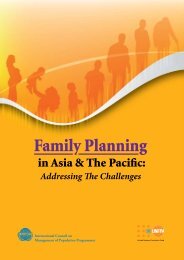national reproductive health strategy - Ministry of Public Health ...
national reproductive health strategy - Ministry of Public Health ...
national reproductive health strategy - Ministry of Public Health ...
You also want an ePaper? Increase the reach of your titles
YUMPU automatically turns print PDFs into web optimized ePapers that Google loves.
National Reproductive <strong>Health</strong> Strategy (2012–2016)Unmet need for BP/FP (proportion <strong>of</strong> married women 15–49 years who do not wantany more children during the next two years but are not using any method <strong>of</strong>contraception)Percentage <strong>of</strong> women referred to <strong>health</strong> facilities by CHWs Adolescent birth rate (number <strong>of</strong> live births per 1,000 population <strong>of</strong> women 15–19years)Component 3: Sexually Transmitted Infections and HIV/AIDSThe extent and nature <strong>of</strong> sexually transmitted infections (STIs) in Afghanistan is largely unknown,because no prevalence studies have been conducted yet. National-level prevention, diagnosis,management and follow-up <strong>of</strong> STIs have not been the responsibility <strong>of</strong> any division <strong>of</strong> the MoPH untilnow. Because <strong>of</strong> the close link between RH and STIs, the RHD will initiate an STI intervention<strong>strategy</strong>. Since STIs and HIV/AIDS are also closely linked, RHD will coordinate with the activities <strong>of</strong>the HIV/AIDS Control Programme and its partners, the Curative Medicine, Child and Adolescent<strong>Health</strong> and BPHS Directorates, and the GCMU. Elements <strong>of</strong> the new STI <strong>strategy</strong> are listed below.Strategic Approach 3.1: Improve the quality <strong>of</strong> STI clinical services3.1.1. Integrate STI management and HIV screening and primary prevention into BPHS and EPHSservices3.1.2. Monitor progress in STIs using the <strong>Health</strong> Management Information System (HMIS)3.1.3. Identify resources for further STI/HIV/AIDS prevalence researchStrategic Approach 3.2: Build <strong>health</strong> workers’ capacity in STI management3.2.1 Collaborate with implementing partners to allocate resources for the training <strong>of</strong> <strong>health</strong>workers in STI prevention, identification and treatment Coordinate with implementing partners for the development <strong>of</strong> an LRP for STIs.Coordinate with implementing partners the implementation <strong>of</strong> an STI training programfor <strong>health</strong> workers in STI management including the syndromic approach.Include STI management in RH workers job descriptions.Strategic Approach 3.3: Increase public awareness <strong>of</strong> STIs3.3.1. Collaborate with the IEC and HIV/AIDS departments on the development <strong>of</strong> IEC/BCCmaterials for STI prevention, including those that promote condom useMonitoring indicators: Percentage <strong>of</strong> young men and women age 15–24 years (the at-risk group) who havecorrect comprehensive knowledge <strong>of</strong> STI/HIV preventionPercentage <strong>of</strong> new cases identified through the HMISComponent 4: Strategic Approaches to Breast and Cervical CancerOnly very limited services are available in Afghanistan for the diagnosis and treatment <strong>of</strong> breast andcervical cancer. No radiotherapy or chemotherapy centres exist in the country. Similarly, expertise insurgical treatment <strong>of</strong> breast and cervical cancers is only minimally available. The total mortality ratePage 21














